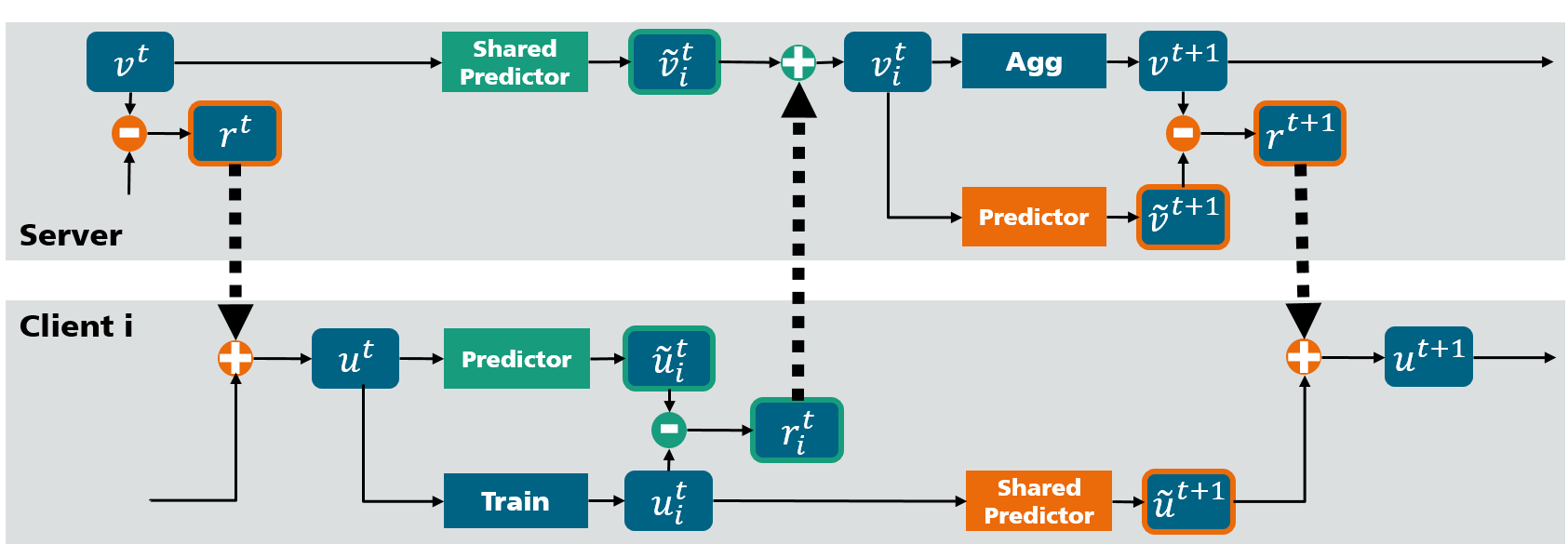ResFed is a Residual-based Federated Learning Framework with deep residual compression for both up- or/and down-streaming.
In this code appendix, we provide three main modules as follows:
- Dataset preprocessing: Dividing the dataset into a number of clients w.r.t. federated settings
- ResFed implementation: Pytorch implementation of Residual-based Federated Learning Framework with deep residual compression
- Postprocessing: Visualization of the training results and compression ratio for evaluation.
- Python (3.7)
- PyTorch (1.8.1)
- Torchvision (0.9.1)
- Numpy (1.21.5)
Run: pip install -r requirements.txt to install the required packages.
This preprocessing aims to divide the entire datasets into a dedicated number of clients with respect to federated settings.
Depending on the value of -c (the number of classes in each local dataset), the entire dataset are split into Non-IID datasets in terms of label distribution skew.
By calling the function divide_data(), one of the used datasets in this paper, i.e. MNIST, CIFAR-10, Fashion-MNIST, SVHN, CIFAR-100 is downloaded via Torchvision automatically.
The module has been integrated into the main functions of ResFed.
python resfed_main.py -n 10 \
-m 300 \
-c 10 \
-lr 0.01 \
-bs 64 \
-mn 'LeNet' \
-ds 'MNIST' \
-rd 'results' \
-e 1 \
-is 1 \
-uls 0.95 \
-dls 0.95 \
-ul 1 \
-dl 1 \
-qe 1 \
-ulp 1 \
-dlp 1 \
-cw 0
--num_client-n: Number of the clients.--num_comm_round-m: Number of communication rounds.--num_local_class-c: Number of the classes in each client.--lr-lr: Learning rate.--bs-bs: Batch size.--model_name-mn: Model name, e.g. "LeNet", "CNN", "ResNet18", etc.--dataset-ds: Dataset name, one of the following four datasets: "MNIST", "CIFAR-10", "FashionMnist", "SVHN", "CIFAR-100".--res_dir-rd: Directory for the result files, default directory is "./results".--num_epoch-e: Number of local epochs.--i_seed-is: Seed number.--ul_sparsity-uls: Sparsity for deep compression in up-streaming.--dl_sparsity-dls: Sparsity for deep compression in down-streaming.--resfed_upstream-ul: Flag for ResFed in up-streaming.--resfed_downstream-dl: Flag for ResFed in down-streaming.--quan_coef-qe: Quantization coefficient.--ul_proto_id-ulp: Prediction rule of the predictor for up-streaming.--dl_proto_id-dlp: Prediction rule of the predictor for down-streaming.--comp_weight-cw: Flag for model weight compression.
Please run python postprocessing/eval_main.py -rr 'results' to plot the testing accuracy and training loss by the increasing number of epochs or communication rounds.
Note that the labels in the figure is the name of result files
If you find ResFed is useful, please cite our work:
@ARTICLE{10283999,
author={Song, Rui and Zhou, Liguo and Lyu, Lingjuan and Festag, Andreas and Knoll, Alois},
journal={IEEE Internet of Things Journal},
title={ResFed: Communication-Efficient Federated Learning With Deep Compressed Residuals},
year={2024},
volume={11},
number={6},
pages={9458-9472},
doi={10.1109/JIOT.2023.3324079}}